
Flies are insects of the order Diptera, the name being derived from the Greek δι- di- "two", and πτερόν pteron "wing". Insects of this order use only a single pair of wings to fly, the hindwings having evolved into advanced mechanosensory organs known as halteres, which act as high-speed sensors of rotational movement and allow dipterans to perform advanced aerobatics. Diptera is a large order containing more than 150,000 species including horse-flies, crane flies, hoverflies, mosquitoes and others.
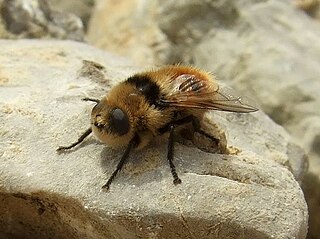
The name deer botfly refers to any species in the genus Cephenemyia, within the family Oestridae. They are large, gray-brown flies, often very accurate mimics of bumblebees. They attack chiefly the nostrils and pharyngeal cavity of members of the deer family. The larva of Cephenemyia auribarbis, infesting the stag, is called a stagworm. The genus name comes from the Greek kēphēn, meaning 'drone bee', and myia, meaning 'fly'.

The Asilidae are the robber fly family, also called assassin flies. They are powerfully built, bristly flies with a short, stout proboscis enclosing the sharp, sucking hypopharynx. The name "robber flies" reflects their expert predatory habits; they feed mainly or exclusively on other insects and, as a rule, they wait in ambush and catch their prey in flight.

Cobboldia is a genus of parasitic flies in the family Oestridae. Adult flies of Cobboldia elephantis lay their eggs near the mouth or base of the tusks of Asian elephant while the related Cobboldia loxodontis parasitizes African elephants. The larvae hatch and develop in the mouth cavity and later move to the stomach. On maturing, the third instar larvae exit from the mouth and drop to the ground to pupate.

The Perilampidae are a small family within the Chalcidoidea, composed mostly of hyperparasitoids. The family is closely related to the Eucharitidae, Chrysolampidae, and Eutrichosomatidae. As presently defined, six genera are described worldwide. They are often brilliantly metallic, with robust mesosomae and a small, triangular metasomae. They are generally very strongly sculptured. The prothorax is typically very broad and disc-like, and the labrum is multidigitate, a feature shared with the Eucharitidae.
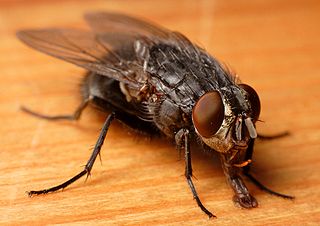
Calliphora vicina is a member of the family Calliphoridae, which includes blow flies and bottle flies. These flies are important in the field of forensic entomology, being used to estimate the time of a person's death when a corpse is found and then examined. C. vicina is currently one of the most entomologically important fly species for this purpose because it arrives at and colonizes a body following death in consistent timeframes.
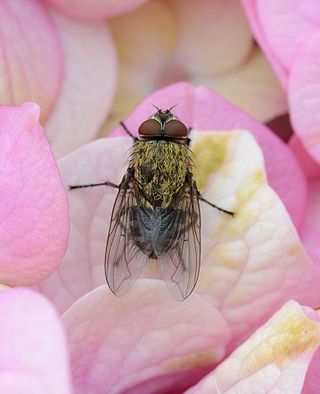
Pollenia rudis, the common cluster fly, is a species of fly in the family Polleniidae. Pollenia rudis is also known as the attic fly, the loft fly, pollenie du lombric [French], and the buckwheat fly. During the autumn and winter months, Pollenia rudis can be found overwintering inside attics or lofts. This sluggish species can be found “clustering” near the interior windows of a warm structure.

Muscina is a genus of flies that belongs to the family Muscidae, currently consisting of 27 species. They are worldwide in distribution and are frequently found in livestock facilities and outside restrooms. The most common species are M. stabulans, M. levida, and M. prolapsa. Muscina flies commonly breed in manure and defecate on food, which has been linked to the spread of some disease and illnesses. The occurrence of Muscina larvae on dead bodies has led to their regular use in forensic investigations, as they may be used to estimate the time of death. Research have shown the prevalence of certain species of Muscina flies as vectors of diseases such as poliomyelitis.

Calliphora livida is a member of the family Calliphoridae, the blow flies. This large family includes the genus Calliphora, the "blue bottle flies". This genus is important in the field of forensic entomology because of its value in post-mortem interval estimation.
Calliphora latifrons is a species of blue bottle fly.

Gecarcinus ruricola is a species of terrestrial crab. It is the most terrestrial of the Caribbean land crabs, and is found from western Cuba across the Antilles as far east as Barbados. Common names for G. ruricola include the purple land crab, black land crab, red land crab, and zombie crab.
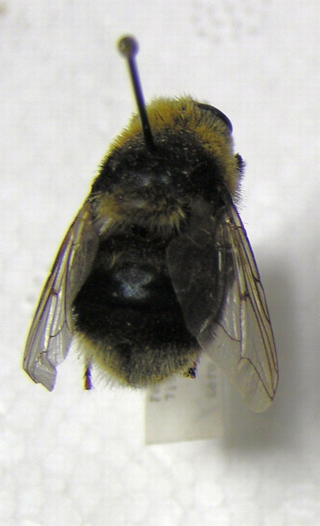
Cephenemyia ulrichii or the moose botfly, also called the elk botfly, moose nose botfly or moose throat botfly, is a large botfly that resembles a bumblebee. In the wild, they attack chiefly the nostrils and pharyngeal cavity of moose, but have been found in other deer species. There have also been several cases of C. ulrichii squirting their larvae into the eyes of human beings, a somewhat painful event that requires medical attention to forestall any possibility of serious damage.

Cephenemyia trompe, also known as the reindeer nose botfly, is a species of botfly first described by Adolph Modéer in 1786. It belongs to the deer botfly genus Cephenemyia. This fly is parasitic on reindeer. It is one of two Cephenemyia species found only in Scandinavia.

Saissetia coffeae, known generally as hemispherical scale, is a species of soft scale insect in the family Coccidae. Other common names include the helmet scale and coffee brown scale.
Cuterebra emasculator, the squirrel bot fly, is a species of new world skin bot fly in the family Oestridae. The species was first described by Asa Fitch in 1856. It is an internal parasite of chipmunks and tree squirrels in the eastern United States. The species' name comes from the belief that larvae ate the testicles of chipmunks. This belief is false, as parasitism by the larvae of these flies does not result in lower fertility - chipmunks mate in the spring, while botfly infections occur in the summer, and the larva do not impede sperm production as they reside below the skin.
Pterodontia flavipes is a species of small-headed flies. Adult males are 5.5–10.5 mm in size, while adult females are 5–9 mm. The larvae are thought to enter their host spiders at the leg articulations. First instar larvae of the species have also been recorded attacking the mites Podothrombium and Abrolophus.

Gasterophilus nasalis is a species of the genus Gasterophilus and family Oestridae. This species is found worldwide, but prominently present within the summer months. This species of G. nasalis primarily targets equines, such as horses, donkeys and the plains zebra. However, it's known that it targets cattle as well, along with mild cases of companion animals.
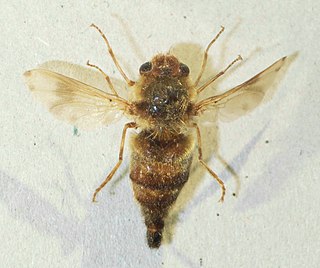
Gasterophilus intestinalis, also known as horse bot fly, is a species of insect of the family Oestridae, and is found worldwide. The adults, which have a bumblebee-like appearance, are prominently active in the summer. G. intestinalis is primarily a parasite of horses, mules and donkeys, rarely of other animals.

Physocephala tibialis is a species of thick-headed fly found throughout the eastern United States, often near flowering plants. The adult fly is primarily black with a yellow face and thin white stripes on the abdomen. It is commonly found along the east coast of the United States and is often found near flowering plants.
Cephenemyia pratti is a species of nose bot flies in the family Oestridae.















